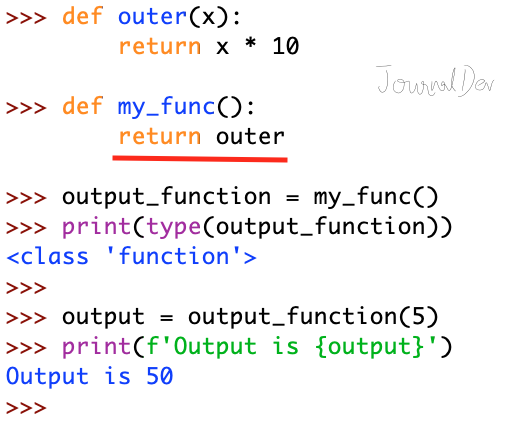- Log in to:
- Community
- DigitalOcean
- Sign up for:
- Community
- DigitalOcean

The python return statement is used to return values from the function. We can use the return statement in a function only. It can’t be used outside of a Python function.
Python Function without return statement
Every function in Python returns something. If the function doesn’t have any return statement, then it returns None.
def print_something(s):
print('Printing::', s)
output = print_something('Hi')
print(f'A function without return statement returns {output}')
Output:

Python Return Statement Example
We can perform some operation in a function and return the result to the caller using the return statement.
def add(x, y):
result = x + y
return result
output = add(5, 4)
print(f'Output of add(5, 4) function is {output}')
Output:

Python return statement with expression
We can have expressions also in the return statement. In that case, the expression is evaluated and the result is returned.
def add(x, y):
return x + y
output = add(5, 4)
print(f'Output of add(5, 4) function is {output}')
Output:

Python return boolean
Let’s look at an example where we will return the boolean value of the argument of a function. We will use bool() function to get the boolean value of the object.
def bool_value(x):
return bool(x)
print(f'Boolean value returned by bool_value(False) is {bool_value(False)}')
print(f'Boolean value returned by bool_value(True) is {bool_value(True)}')
print(f'Boolean value returned by bool_value("Python") is {bool_value("Python")}')
Output:

Python return string
Let’s look at an example where our function will return the string representation of the argument. We can use the str() function to get the string representation of an object.
def str_value(s):
return str(s)
print(f'String value returned by str_value(False) is {str_value(False)}')
print(f'String value returned by str_value(True) is {str_value(True)}')
print(f'String value returned by str_value(10) is {str_value(10)}')
Output:

Python return tuple
Sometimes we want to convert a number of variables into a tuple. Let’s see how to write a function to return a tuple from a variable number of arguments.
def create_tuple(*args):
my_list = []
for arg in args:
my_list.append(arg * 10)
return tuple(my_list)
t = create_tuple(1, 2, 3)
print(f'Tuple returned by create_tuple(1,2,3) is {t}')
Output:

Further Reading: Python *args and **kwargs
Python function returning another function
We can return a function also from the return statement. This is similar to Currying, which is the technique of translating the evaluation of a function that takes multiple arguments into evaluating a sequence of functions, each with a single argument.
def get_cuboid_volume(h):
def volume(l, b):
return l * b * h
return volume
volume_height_10 = get_cuboid_volume(10)
cuboid_volume = volume_height_10(5, 4)
print(f'Cuboid(5, 4, 10) volume is {cuboid_volume}')
cuboid_volume = volume_height_10(2, 4)
print(f'Cuboid(2, 4, 10) volume is {cuboid_volume}')
Output:

Python function returning outer function
We can also return a function that is defined outside of the function with return statement.
def outer(x):
return x * 10
def my_func():
return outer
output_function = my_func()
print(type(output_function))
output = output_function(5)
print(f'Output is {output}')
Output:

Python return multiple values
If you want to return multiple values from a function, you can return tuple, list, or dictionary object as per your requirement. However, if you have to return a huge number of values then using sequence is too much resource hogging operation. We can use yield, in this case, to return multiple values one by one.
def multiply_by_five(*args):
for arg in args:
yield arg * 5
a = multiply_by_five(4, 5, 6, 8)
print(a)
# showing the values
for i in a:
print(i)
Output:

Summary
The python return statement is used to return the output from a function. We learned that we can also return a function from another function. Also, expressions are evaluated and then the result is returned from the function.
You can checkout complete python script and more Python examples from our GitHub Repository.
Thanks for learning with the DigitalOcean Community. Check out our offerings for compute, storage, networking, and managed databases.
About the author
Java and Python Developer for 20+ years, Open Source Enthusiast, Founder of https://www.askpython.com/, https://www.linuxfordevices.com/, and JournalDev.com (acquired by DigitalOcean). Passionate about writing technical articles and sharing knowledge with others. Love Java, Python, Unix and related technologies. Follow my X @PankajWebDev
Still looking for an answer?
- Table of contents
- Python Function without return statement
- Python Return Statement Example
- Python return statement with expression
- Python return boolean
- Python return string
- Python return tuple
- Python function returning another function
- Python function returning outer function
- Python return multiple values
- Summary
Deploy on DigitalOcean
Click below to sign up for DigitalOcean's virtual machines, Databases, and AIML products.
Become a contributor for community
Get paid to write technical tutorials and select a tech-focused charity to receive a matching donation.
DigitalOcean Documentation
Full documentation for every DigitalOcean product.
Resources for startups and SMBs
The Wave has everything you need to know about building a business, from raising funding to marketing your product.
Get our newsletter
Stay up to date by signing up for DigitalOcean’s Infrastructure as a Newsletter.
New accounts only. By submitting your email you agree to our Privacy Policy
The developer cloud
Scale up as you grow — whether you're running one virtual machine or ten thousand.
Get started for free
Sign up and get $200 in credit for your first 60 days with DigitalOcean.*
*This promotional offer applies to new accounts only.
